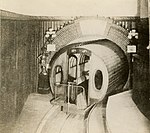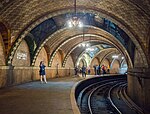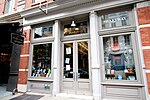The Cary Building at 105-107 Chambers Street, extending along Church Street to Reade Street, in the Tribeca neighborhood of Manhattan, New York City, was built in 1856-1857 and was designed by Gamaliel King and John Kellum ("King & Kellum") in the Italian Renaissance revival style, with the cast-iron facade provided by Daniel D. Badger's Architectural Iron Work. The five-story twin-facaded building was constructed for William H. Cary's Cary, Howard & Sanger, a dry goods firm.Although built as a commercial structure, the Cary Building is now residential. As a result of the widening of Church Street in the 1920s, a 200-foot-long wall of unadorned brick is now exposed on the east side of the building; as Christopher Gray observed in The New York Times, comparing the structure to cast-iron buildings with facades obscured by modern signage, "There is not too little of the Cary Building but too much."In 1973, the artist Knox Martin was commissioned to create a 280-foot canopy that wrapped around the building. Ada Louise Huxtable wrote in The New York Times: "...credited Knox Martin with the graphics, including the supersign on the building's side and the continuous, brightly patterned abstract awning sheltering the shops. It is a fine example of combining new with old for practicality, continuity and art."The building was designated a New York City landmark in 1982, and was listed on the U.S. National Register of Historic Places in 1983. The building was once home to The New York Sun.











